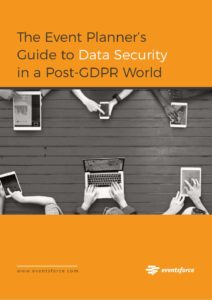At a time when budgets are squeezed and downsizing has become commonplace, having a quantifiable return on events has never been more important. And technology plays a key role here. Event tech systems help organisations collect important data around their events (registration forms, surveys, apps) and create all sorts of reports that help in measuring event success. In fact, according to the results of a new Eventsforce study, calculating ROI and measuring success is the number one reason why organisations are collecting data from events.
NEW – The Changing Role of Event Data: New Challenges & Opportunities
The problem, however, is that the amount of data generated around an event can be overwhelming: from website traffic and social media engagement to registration and attendance. From the quality of your attendees to their feedback and evaluation. From the revenue generated to conversion rates and sales leads. Figuring out what tools you need to measure the data that matters is not as simple as one would hope.
11 Effective Data Collection Tools for Events
There are a number of data collection tools that helps organisations gather and analyse valuable information around their events. But which ones should you use?
Have a look below for a list of some of the most effective event data collection tools based on feedback from more than 120 senior event planners:
1. Registration Systems
Most organisations today use some form of automated system to manage registrations around their events. And for good reason too. Our study found that registration systems were seen as the most effective data collection tool for measuring event success. As well as default information like names, addresses and contact details of your attendees, registration systems like Eventsforce allow you to collect more personalised data by segmenting your audiences into different categories (attendees, sponsors, exhibitors, speakers, VIPs etc.). For example, you can find out what proportion of attendees cite education as the primary reason for coming to your event or see which specific sessions your VIPs are most interested in attending. This kind of information can give really valuable insight in the way you plan, manage and evaluate the success of all your events.
2. Online Surveys
Post-event surveys often provide the most meaningful feedback for organisers. They can help you gather important information on many aspects of your event – including feedback on your speakers, sessions, catering, prices, exhibitors, sponsors, accommodation, travel and more. Not only does this information help you make any necessary improvements, but more importantly, it can help you figure out whether attendees found value in your event and whether or not they would come again the next time round.
3. Event Management Software
These systems have evolved so much over the last few years that they now sit at the heart of most matters concerning event data. They act as centralised systems that help you capture, track and report on important real-time information on multiple events, including registrations, attendance, session selections, payments, revenue and profits etc. Some systems like Eventsforce also do a good job of integrating (or sharing) their data with other business systems like CRM, finance, marketing and membership solutions. This means event planners can use their event management system to access any relevant data stored in some of these other solutions. For example, event teams will be able to access all the outstanding attendee payments recorded in their organisation’s finance system, which helps them stay on top of their revenue and cashflow forecasts.
Find out how companies like Schroders, Haymarket, The Liberal Dems and the Royal Statistical Society are using data integration to save time and money around their events. Get your FREE copy of ‘The Event Planner’s Guide to Data Integration’ eBook here.
4. Mobile Apps
Event apps have made the whole process of collecting data at events a whole lot easier – from facilitating live polls and Q&As to networking tools that can give insight on who your attendees are meeting with at your event. The analytic tools on these apps can help identify how attendees are engaging with your event and what they find of interest based on their in-app actions. For example, you’ll be able to see exactly how many people showed interest in certain speakers and sessions, or which exhibitors generated the most buzz. This will help determine interest areas across different types of attendees – it will also help in things like assessing speakers and deciding whether or not to bring them back the following year.
5. Social Media Tools
Event planners can really maximize their social media outreach by using analytic tools that measure engagement numbers on their social networks, like Twitter, Facebook, LinkedIn and Instagram. Using tools like Hootsuite, Oktopost or Mention, you can do things like see which platforms are the most effective, find out what content your followers are sharing with their own networks, what is engaging with them emotionally and what is more educational and so on. You can also assess conversions such as registrations, sign ups to newsletters, eBook downloads or anything else you want your followers to do.
6. On-Site Systems
Knowing exactly who turned up at your event and what sessions they attended is something every organisation wants to know. The information helps figure out popular topics and sessions. It also helps profile attendees. On-site systems like the Eventsforce on-site app allow event planners to have instant access to this kind of information at the event itself, which can be very useful. For example, the app can tell you that 30 people have already checked-in to a session and that another 10 are expected to show up. It also shows that the room capacity for that particular session is 50 people. You can use the information to encourage more people to attend by promotions through digital signage, social media or direct notifications on the event app.
7. Audience Engagement Tools
Solutions like Glisser promote engagement and audience participation at events through the use of smartphones. Using the event app, attendees can put questions across to speakers during sessions, rate other questions and see any presentation slides in real-time. The tool allows you to collect and store all the data for post-event analysis, which can help in identifying topics your attendees are interested in – as well as determine the success or shortcomings of your speakers and presentations.
8. Web Analytics
Understanding how people are interacting with your event website is important. Without this understanding, you won’t know the potential problems your event’s online presence is facing. You also won’t be able to make any meaningful changes. Tools like Google Analytics can help you gather important data that tell you whether or not your marketing efforts are actually turning into results. This can include things like detailed demographics on who is visiting your website, where your visitors and registrations are coming from, which content and pages on your website are the most/least popular, conversation rates and the point at which people are abandoning their registrations.
Read: Why is Google Analytics So Important for Event Marketing
9. Networking Tools
Networking is seen as one of the main reasons why people attend events so it makes sense to facilitate this as much as possible for your attendees. Tools like Meeting Manager are usually incorporated within the registration process or event app and they allow attendees to personalise their agendas, see who is attending that may be of interest to them and set up meetings with people they want to meet. The data helps planners get insight on how much ‘networking’ is being done at their event and the kind of people, exhibitors or topics your attendees are most interested in.
10. RFID/NFC Tools
Solutions using these technology platforms are doing particularly well at trade shows as they don’t depend on Wi-Fi technology but can track real-time data around visitor footprint on the show floor. One example of this is Poken, which allows attendees to use smart badges to virtually swap business cards and instantly collect any event collateral. It helps exhibitors track exactly who is visiting their booth, which is great in measuring the ROI of participation. It also gives planners insight on how attendees are moving and interacting around the venue – so you can quickly identify hot and cold spots and adjust your marketing and promotional activities accordingly.
11. Chatbots
Chatbots like Concierge EventBot are relatively new in the industry. They let attendees have conversations with event planners (via their artificial intelligence surrogates) using platforms like the event website, Facebook Messenger or the text-messaging feature of their smartphones. Last month, South by Southwest used its own chatbot to provide attendees with automated concierge-style assistance on demand. More than 16,000 app users submitted 56,000 questions to the bot, asking things like ‘What time is Joe Biden speaking?’ or ‘What hip-hop artists are playing on Wednesday?’ and ‘Where can I find Tacos?’. As well as personalising the attendee’s event experience, all interactions and notifications on the chatbot are logged and available for analysis and reporting. Standard reports include usage by messaging channel, unique users, messages grouped by topics, notifications, external link clicks, human assisted requests and conversation updates.
Conclusion
All the tools mentioned in this article can be useful for different reasons. The most important consideration you need to make is figuring out from the very start what data you want to collect from your events and how that data can bring value to your organisation. Whether that’s the number of people who registered for your event compared to the actual number who attended. Whether they used your app for engagement or networking. Once you know the what you want to measure, create a plan that outlines your data strategy and identifies the tools you can use to track, manage and report the data that actually matters.
Are there any other effective data collection tools you’d like to add to this list? Please share and let us know – we’d love to hear your comments!
Want to be a tech savvy event planner? Sign up to our weekly EventTech Talk Newsletter here and get updates on all the latest technology trends, discussions and debates shaping the events industry today.











